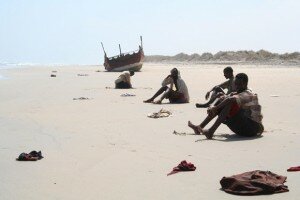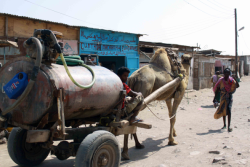YEMEN: Somali refugees struggle in parched Aden slum
 ADEN, 7 December 2009 (IRIN) – Public access to water in Basateen, a slum on the outskirts of Yemen’s southern port city of Aden and home to some 16,000 Somali refugees, has become extremely limited, according to the UN Refugee Agency (UNHCR).
ADEN, 7 December 2009 (IRIN) – Public access to water in Basateen, a slum on the outskirts of Yemen’s southern port city of Aden and home to some 16,000 Somali refugees, has become extremely limited, according to the UN Refugee Agency (UNHCR).
The slum’s Somali inhabitants, most of whom if employed do menial jobs, say they have to purchase water from private companies to meet their daily needs.
According to Hadiga Ali Sayid from the Adventist Development and Relief Agency, an international NGO promoting health and providing food and water, many poor refugee families who are unable to buy water rely on charity from local mosques to survive.
“I get 20,000 Yemeni riyals [US$100] a month working as a cleaner, and one load of water from a private company costs 1,500 riyals [about $7.5],†said Amina Mohamed, a Somali refugee who has been living in Basateen for 15 years.
She told IRIN that paying for water is difficult for her and the 20 other members of her extended family living under the same roof. Amina’s uncle, a taxi driver, is the only other income earner in the family. Their house has no public water supply.
In the early 1990s, Yemeni returnees from Somalia and Somali nationals fleeing conflict began to settle in Basateen. A well-irrigated suburb 25 years ago – reflecting its name which means “gardens†in Arabic – Basateen is now a slum and, according to the UNHCR, the poorest district in Aden city.
 Josef Mueller, UNHCR’s water and sanitation expert, said access to water in the slum was “limited†both in terms of quantity and quality, and some of the privately owned wells had become polluted with sewage.
Josef Mueller, UNHCR’s water and sanitation expert, said access to water in the slum was “limited†both in terms of quantity and quality, and some of the privately owned wells had become polluted with sewage.
The UN Children’s Fund (UNICEF) and UNHCR are working with the authorities to chlorinate all 18 wells in Basateen to avoid an outbreak of water-borne diseases.
According to the 2006 Human Development Report entitled Beyond Scarcity: Power, Poverty and the Global Water Crisis by the UN Development Programme (UNDP), Yemen has one of the world’s lowest freshwater availability levels – 198 cubic metres per person. The country’s population is projected to double by 2025 to some 40 million, and per capita availability of water could fall by a third, the report said.
Water riots
In August 2009, serious water shortages led to riots and the death of one person in Aden, according to local media.
The Yemen Times newspaper, said 75 percent of Aden’s water supply was re-directed to the cities of Zunjubar and Ja’ar three months prior to the riots because of water crises in those cities.
Deputy Director-General of the Aden Water Corporation Saeed H. Qassem blamed the problem on random well digging in the city. “We have constantly raised the matter… but no one would listen and the result is the present situation in Aden,†he was quoted by Yemen Times as saying.
Basateen’s water problems are unlikely to disappear until Aden’s water supply situation is remedied, Mueller said.
lk/at/cb
Comments
comments
 Calendar
Calendar




































